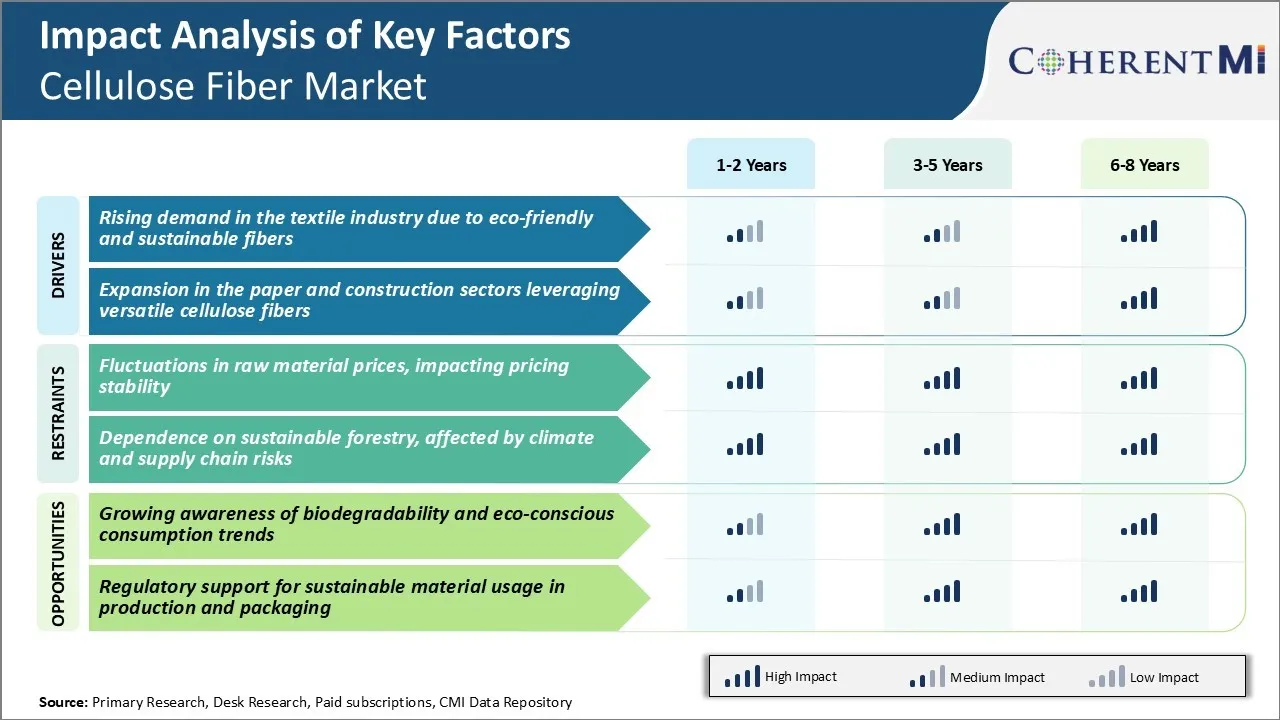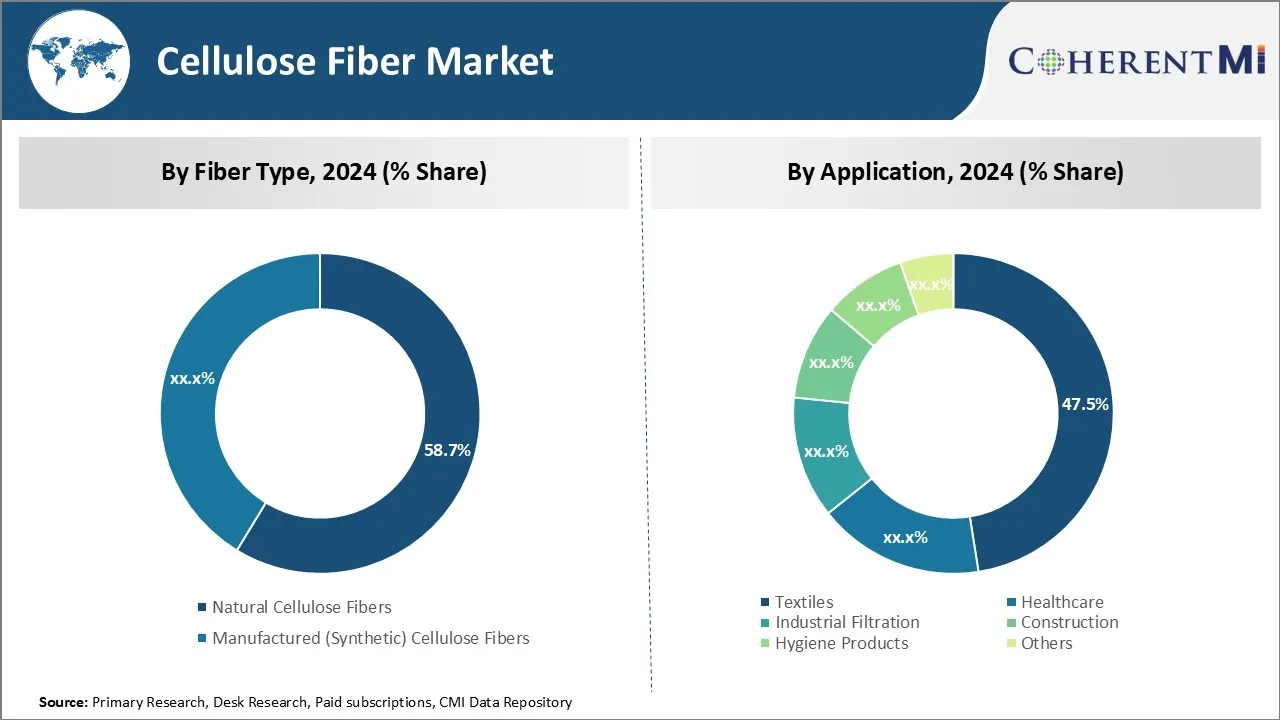セルロース繊維市場 サイズ - 分析
市場規模(米ドル) Bn
CAGR5.00%
| 調査期間 | 2025-2032 |
| 推定の基準年 | 2024 |
| CAGR | 5.00% |
| 市場集中度 | Medium |
| 主要プレーヤー | レンジングAG, サテリホールディングス株式会社, グラシム産業株式会社, Kelheim Fibres, ドイツ, タンシャン山陽グループ その他 |
お知らせください!
セルロース繊維市場 トレンド
市場ドライバ - 紙および建設セクターの拡張は、汎用セルロース繊維をレバレッジ
セルロース繊維は、アパレルやホームテキスタイルを超えて多面的なアプリケーションを見つけます。 高強度、柔軟性、耐湿性を兼ね備えた独自の組み合わせにより、紙や建設部門に評価できます。 ペーパー製造では、セルロース繊維は原料の基盤を提供し、主要な構造ロールをします。 これは、セルロース繊維市場での現状のシナリオにおける食品および医薬品分野からの需要だけでなく、eコマースの増殖に有意である。
建設中、リサイクル新聞で作られたセルロース絶縁バットは、広く普及しています。 優秀な防音および断熱能力によって、セルロースは建築者に緑の建物の標準によって処理される重要な持続可能性のマイルストーンを達成するのを助けます。 建設業界は、建設用部品用のセルロース繊維複合材を新たに探索しています。
そのため、主要なエンドユース部門を横断する汎用性の高いアプリケーションは、セルロース繊維を貴重な再生可能エネルギー資源として強調しています。 R&Dの継続的な投資は、独自の特性を活用するより革新的な方法を発見することが期待されています。 これは、紙、構造、およびその他のエンドユース部門のセルロース繊維市場での選手のための成長アベニューを推進します。

市場機会 - 生分解性および環境意識消費の傾向の認識を成長させる
セルロース繊維市場の主要な機会の1つは、グローバルで持続可能性に重点を置いています。 環境問題の高まりに伴い、プラスチック汚染の低減や再生繊維の使用など、消費者の意識が高まっています。
コットン、ジュテ、竹などの繊維を含有するアパレル、ホームテキスタイル、その他、環境フットプリントを抑えた製品が増えています。 これは、セルロース繊維メーカーが環境にやさしい代替品として製品を販売するためのユニークな販売ポイントとして動作します。
政策レベルのサポートだけでなく、バイオ分解性アスペクトは、繊維を活用した業界の需要の重要なドライバーになっています。 メーカーは、食品包装、農業繊維、パーソナルケアなどのセルロース繊維の革新的なアプリケーションを開発することにより、成長するエコ意識消費トレンドに資本を供給することができます。
主要プレーヤーが採用した主な勝利戦略 セルロース繊維市場
プロダクト革新: 新しい革新的な製品の開発は、Lnzing AGのようなセルロース繊維市場でプレイヤーがエッジを得るのを助けた重要な戦略です。 2018年に、Lnzingはリサイクルされた木および綿の無駄からなされる新しいReFibraのセルロース繊維を進水させました。 この繊維は高い持続可能性の資格情報を持っています。 継続的革新により、Lezingは、TencelやEcoVeroなどの特殊繊維のリーダーとして確立しました。
市場拡大: : : 衣料品や衛生製品に用いられるセルロース繊維の主要市場であるアジアに進出しています。 2020年、グラシム・インダストリーズは、インドのポジションを強化し、アジアに拡大するべく、ランシング・AGのビスコース事業を買収しました。
サステナビリティフォーカス:顧客はますますます環境に優しくセルロース プロダクトを好みます。 LenzingやAditya Birlaなどの企業は、再生可能な原材料を使用して、環境フットプリントを削減し、持続可能な林業に焦点を当てています。
セグメント分析 セルロース繊維市場

アプリケーションによる洞察: 繊維は成長の嘘のところです
セルロース繊維の適用内で、織物の区分は2024年にセルロース繊維の市場の47.5%のシェアに貢献します。 これは、すべての衣料品製造レベルにわたって広範な、汎用性の高い使用によるものです。 親密なアパレルから重いアウターウェアまで、セルロース由来の糸はほぼすべてのタイプの生地に不可欠です。 綿のTシャツやポリエステルのズボンなどの重要な商品や、高ファッションに組み込まれた高級素材のバックボーンを形成します。
デモグラフィックも織物の継続的な成長を支持しています。 フィットネス、ウェルネス、サステイナビリティに関する消費者の優先順位は、自然、通気性のある素材に対する好みのピボットとして、アクティブなライフスタイルや惑星のためのより健康なものとして認識されています。
技術的な織物は別の区域の拡張を表します。 専門化されたセルロース ベースのプロダクトは医学の生地、フィルター、地質学および他の産業nonwovensの厳密な条件を満たします。 ここでは、生体適合性、微小構造、均一性、および調整されたポリマー混合物などの特性は、機能性を最適化します。 今後数年間、セルロース繊維市場で重要なトレンドを発揮します。
追加の洞察 セルロース繊維市場
- アジア・パシフィック・ドミナンス: 豊富な原材料の可用性と堅牢な繊維産業により、セルロース繊維市場で最大のシェアを保有しています。
- 環境影響意識: 合成繊維の環境影響についての意識を育てることは、セルロース繊維に向かって消費者をステアリングします。
- 持続可能な素材への主要なファッションブランドのシフトは、セルロース繊維メーカーとのパートナーシップを強化しました。
- アジア・太平洋諸国の政府は、農村の経済性を高めるために天然繊維の使用を促進しています。
競合の概要 セルロース繊維市場
セルロース繊維市場で動作する主要なプレーヤーは、Lnzing AG、Sateri Holdings Limited、Grsim Industries Limited、Tangshan Sanyou Group、Kelheim Fibres GmbH、Fulida Group Holdings Co.、Eastman Chemical Company、Thai Rayon Public Co. Ltd.、CFF GmbH&Co. KG、中国Bambro Textile Co.、Ltd.、Shandong Helon Textile Sci.&Tech. Co.、Ltd.、および中国ハイテクグループ株式会社。
セルロース繊維市場 リーダー
- レンジングAG
- サテリホールディングス株式会社
- グラシム産業株式会社
- Kelheim Fibres, ドイツ
- タンシャン山陽グループ
セルロース繊維市場 - 競合関係

セルロース繊維市場
(大手プレーヤーが支配)
(多くのプレーヤーが参入し、競争が激しい。)
最近の動向 セルロース繊維市場
- 2024年6月、イーストマンは、持続可能な木材パルプ60%と40%のリサイクル含有量で構成されたNaiaTM Renewを導入しました。 イーストマンの分子リサイクル技術により、この革新的な材料を生産しています。 木材パルプと組み合わせることで、新たなセルロース繊維を創造する分子成分に廃棄物をリサイクルする技術。
- 2024年2月、イーストマンとカーギルは、バイオベースの包装材料を作成するために提携し、環境に優しい包装オプションを強化しました。
- 2023年8月、サテリは1万トンのリセル繊維の生産能力を拡大しました。 サテリ(Nantong)ファイバー株式会社での生産開始を成功させ、サテリの年間総ロヨセル容量を250,000トンに引き上げました。
- 2023年5月、ダイセル株式会社では、日本におけるセルロースエステルの生産能力を拡大し、地域における需要増加に対応することを目指した重要な投資を発表しました。
セルロース繊維市場 セグメンテーション
- 繊維のタイプによって
- 自然なセルロース繊維
- コットン
- ジュート
- 木材パルプ
- その他
- 製造(合成)セルロース繊維
- ビスコース
- リヨセル
- モーダル
- アセテート
- トライアセテート
- 自然なセルロース繊維
- 用途別
- テキスタイル
- ヘルスケア
- 産業ろ過
- 建設工事
- 衛生製品
- その他

購入オプションを検討しますか?このレポートの個々のセクション?
Yash Doshi はシニア マネジメント コンサルタントです。APAC、EMEA、南北アメリカにおけるさまざまな分野で 12 年以上にわたり、リサーチの実施とコンサルティング プロジェクトの取り扱いに携わってきました。
化学会社が複雑な課題を乗り越え、成長の機会を見出すお手伝いをする上で、彼は優れた洞察力を発揮します。彼は、コモディティ、特殊化学品、ファインケミカル、プラスチック、ポリマー、石油化学製品など、化学品バリュー チェーン全体にわたって深い専門知識を持っています。Yash は業界カンファレンスで人気の講演者であり、コモディティ、特殊化学品、ファインケミカル、プラスチック、ポリマー、石油化学製品に関連するトピックに関するさまざまな出版物に寄稿しています。
よくある質問 :
セルロース繊維市場規模はどれくらいですか?
セルロース繊維市場は、2024年のUSD 43.72 Bnで評価され、2031年までにUSD 60.65 Bnに達すると予想されます。
セルロース繊維市場の成長を妨げる重要な要因は何ですか?
原材料価格の変動、価格安定性に影響し、持続可能な林業に対する依存性、気候およびサプライチェーンリスクの影響を受け、セルロース繊維市場の成長を妨げる主要な要因です。
セルロース繊維市場の成長を運転する主要な要因は何ですか?
多用途セルロース繊維を活用した繊維業界におけるライジング需要と紙および建設部門の拡大は、セルロース繊維市場を牽引する主要な要因です。
セルロース繊維市場における主要な繊維タイプは?
主要な繊維のタイプ区分は自然なセルロース繊維です。
セルロース繊維市場で動作する主要なプレーヤーはどれですか?
Lenzing AG、Sateri Holdings Limited、Gram Industries Limited、Tangshan Sanyou Group、Kelheim Fibres GmbH、Fulida Group Holdings Co.、Ltd.、Eastman Chemical Company、Thai Rayon Public Co. Ltd.、CFF GmbH&Co. KG、中国Bambro Textile Co.、Ltd、山東 Helon Textile Sci。&Tech. Co. Ltd(中国)、中国Hi-Tech Group Corporationは主要なプレーヤーです。
セルロース繊維市場のCAGRは何ですか?
セルロース繊維市場のCAGRは、2024-2031から4.8%であるように計画されています。